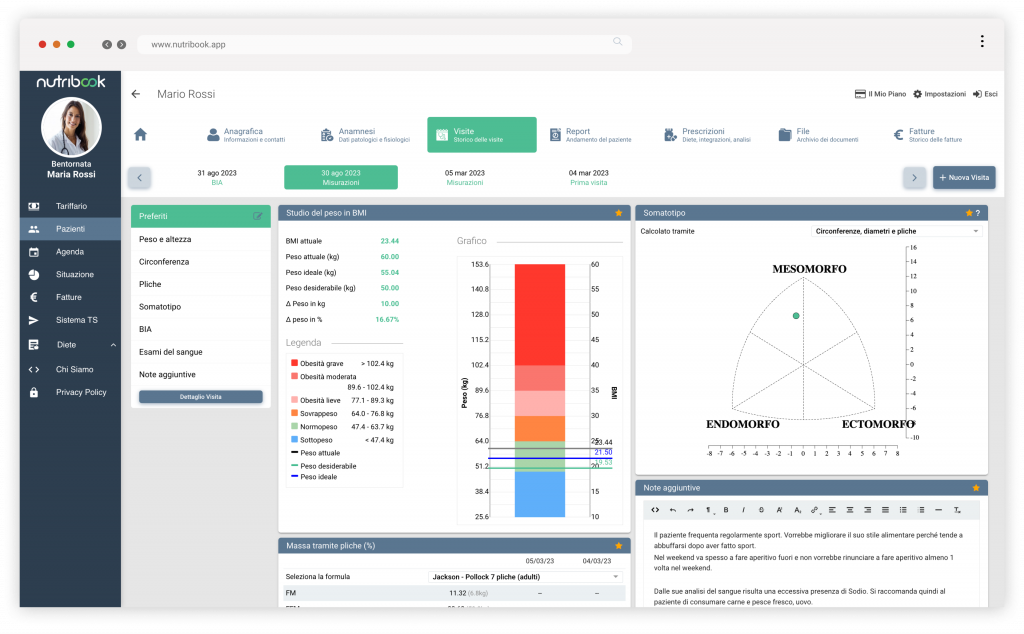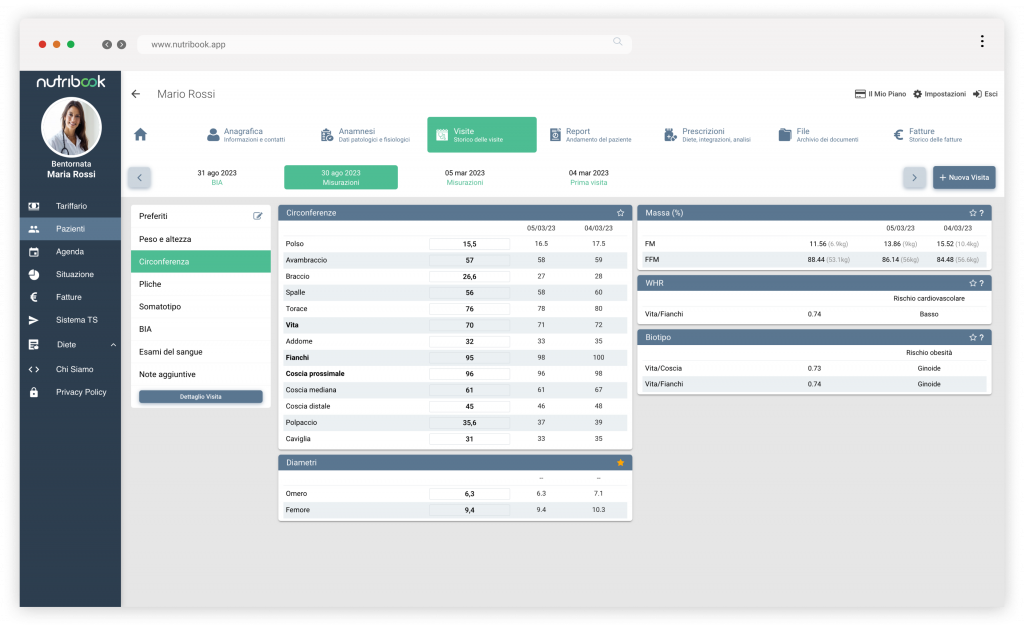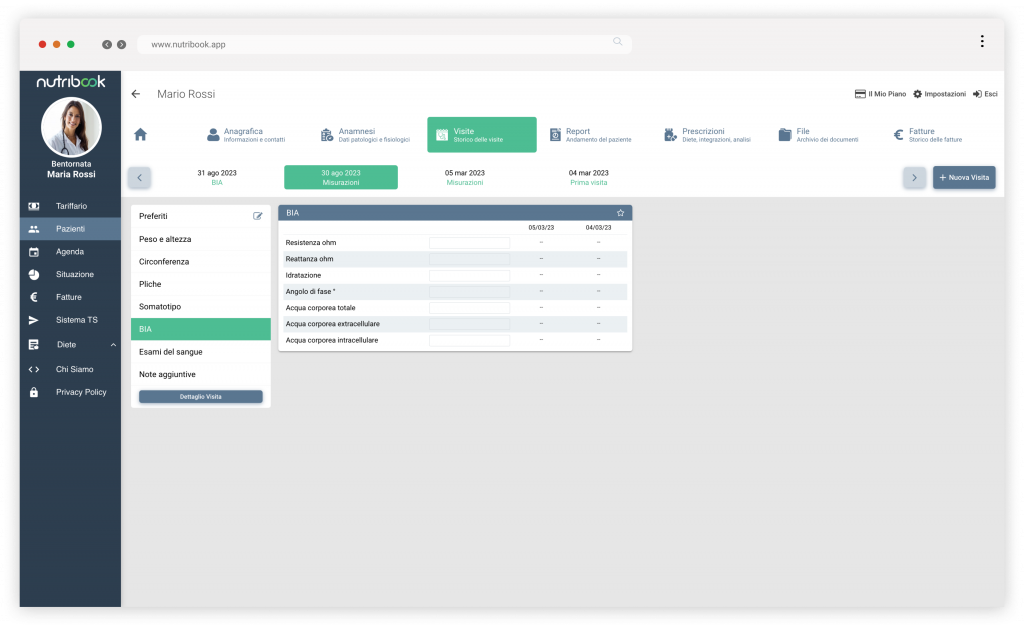Body composition assessment
The Nutribook module for body composition assessment is the best ally for creating personalized meal plans and monitoring progress over time.
A careful analysis of the body composition is in fact essential for the development of effective meal plans: only by determining the state of nutrition and health of the individual it is possible to proceed with the creation of the meal plan that best suits their needs.
The Nutribook module for body composition assessment is the best ally for creating personalized meal plans and monitoring progress over time.
A careful analysis of the body composition is in fact essential for the development of effective meal plans: only by determining the state of nutrition and health of the individual it is possible to proceed with the creation of the meal plan that best suits their needs.
- Favorites
- Weight and height
- Pediatrics
- Circumferences
- Plicometry
- Somatotype
- BIA
- Blood analysis
- Additional notes

With Nutribook you have a wide selection of scientifically validated tools and formulas at your disposal. Analyze and monitor only the values you are interested in based on the type of patient and the different goals to be achieved.
The Favorites section has been designed to group the most useful functions on a single screen, allowing you to conduct accurate analyses with a clear picture of the current situation and a first overview of the general progress.
Select from a wide assortment of tools and formulas based on the type of patient and the goal to be achieved and compose your personalized dashboard to always have an immediate overview of the values you are interested in.
BMI
Record your weight and height and identify your body mass index range at a glance. Classification into weight ranges is only the first step in assessing the body composition. Before proceeding with the analysis of more specific parameters, the calculation of BMI allows you to have a first photograph of the patient. The study of weight results in a convenient graph that allows an immediate comparison between the current weight and the ideal weight in proportion to the height.
Desiderable weight
The graphic visualization of the weight study also allows you to set realistic goals in terms of desirable weight, also distinguishing chromatically the weight bands (underweight, normal weight, overweight, mild, moderate and severe obesity). Carry out the weight study at each visit by setting intermediate goals, the progress report will then allow you to monitor weight changes over time and evaluate the progress of the nutritional path.

Follow the nutritional path of your youngest patients thanks to the dedicated Pediatrics section.
Percentiles
Growth percentile charts allow you to assess whether pediatric patients' body growth is progressing smoothly and adjust their nutritional path accordingly to their specific needs
Monitor the growth of your pediatric patients using percentile tables by choosing from the most used parameters:
- Weight (up to 60 months)
- Height (up to 19 years)
- BMI (up to 19 years)
- TMI (from 10 to 20 years)
It uses the official reference values of the World Health Organization and assesses the growth status of younger patients based on internationally recognized scientific standards.

Refine your body composition analysis by simply recording circumference measurements to calculate fat mass values, WHR and the biotype.
FM e FFM - Fat mass ad fat free mass
The values of FM and FFM are obtained from the De Lorenzo equation, for a quick and precise calculation of the percentage of body fat mass.
WHR - Waist-to-hip ratio
In addition to calculating the fat mass, the Circumferences module also returns the WHR value. For the definition of cardio-vascular risk, the software uses the Bray and Gray 1988 classification (Obesity. Part I - Pathogenesis, Western Journal of Medicine). To learn more about the value calculated by the software, you can access the scientific references of the classification at any time with a simple click in the box.
Biotype
The definition of body biotype based on WHR and proximal waist/thigh ratio classifies the patient in the constitutional phenotypes gynoid and android.
The software gives you the ability to accurately calculate the level of obesity risk using the classification provided by the National Heart, Lung and Blood Institute (USA).

FM e FFM - Fat mass and fat free mass
In this section, you can collect and analyze data related to skinfold measurements. Nutribook offers you the possibility to choose between the most used formulas (James, Durnin and Womersley), to obtain a precise and accurate fat mass calculation.
Compare the results of different formulas to get a more complete perspective on your patients' body composition, identify any discrepancies, and choose the most suitable formula for each patient.
Athlete focus: sum of 7 folds
Accurately and reliably measure and monitor the body fat of your sports patients. The reference to international standards for anthropometric assessment (ISAK, International Society for the Advancement of Kinanthropometry) ensures you an accurate assessment for the generation of the ideal plan.
Progress tracking
Record and track ratings over time. Continuously monitoring progress and any changes in body fat can be very motivating for your patients. View the results of their efforts and make any changes in their nutrition and training schedule.

Somatotype and somatochart
Somatotype analysis conducted with a software guarantees accurate results, eliminating the risk of errors resulting from the use of spreadsheets. The identification of a precise point on the somatochart provides valuable information to develop personalized plans for sports and non-sports patients, optimizing the results by type of body constitution.
Multi-formula: somatotype from anthropometric data and BIA
For somatotype assessment select from the available calculation methods and get precise results thanks to the automatic application of scientifically validated formulas.
You can choose whether to use anthropometric data (circumferences, diameters and folds) or BIA values (resistance, total body water and hydration) to identify your patient’s somatotype on the somatochart.
Consult the progress report for an immediate comparison between the somatochart of the first visit and that of the last recorded visit and check at a glance the changes occured during the nutritional journey.

Bioelectrical impedance analysis
Recording detailed information on the health status of your patients allows you to conduct an in-depth analysis of their body composition in order to develop the most suitable nutritional plan for each individual case. With the BIA module you can record and analyze the bioimpedance meter data in each visit quickly and intuitively. The clear data visualization allows you to compare the progress of values at a glance and verify the effectiveness of the plan over time.
BIA values
Integrate bioimpedance values with anthropometric data to have a complete view of the body composition of your patients. For each visit you have the possibility to enter the values of:
- resistance
- reactance
- hydration
- phase angle
- total body water
- extracellular body water
- intracellular body water
Somatotype from BIA
The software uses scientifically validated formulas (Bertuccioli, Sisti et al) to calculate the somatotype of your patients. Simply enter the resistance, hydration and total body water values to view your patient's position on the somatochart and develop the training plan based on his physical characteristics.

When it comes to identifying the ideal diet for a patient, you are faced with one of the main challenges: taking into account their blood test results. Blood values are critical to understanding the overall health of your patients, as they can reveal specific conditions that require special attention.
For each visit, record the values of the relevant blood tests for drafting the plan so as to always have a complete picture of the data and thus simplifies the evaluation process.
Reference range
The software conducts an immediate comparison of the values entered with the reference ranges. Nutribook clearly and evidently indicates the values that are not within the norm, for an immediate assessment of the state of health of your patient and the development of the plan that best suits his needs.
The possibility to modify the reference ranges and to use different units of measurement according to the method used for the detection of blood values (ELISA, chemiluminescence, HPLC) simplifies and speeds up the process of insertion and evaluation.

The assessment of the state of health and the development of the nutritional plan cannot be based only on numerical values. During the visit, each professional ascertains the patient's condition by requesting feedback on the nutritional plan followed up to that point, and inquires about the perceived sensations and the patient's state of mind.
Thanks to the Additional Notes section you can integrate valuable information, qualitative data on the patient's health status that cannot be recorded in numerical values. In this way you will be able to evaluate whether to make changes to the plan, both based on the progress of the numerical values and based on the experience reported by the patient.
Discover the other features of Nutribook
Do you want to see the software in action?
Book a free DEMO with a product expert to discover all the software’s features.
Or activate a free trial period of the software to test all of its features on your own.




